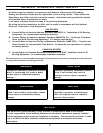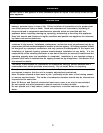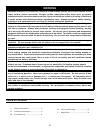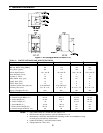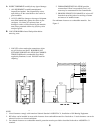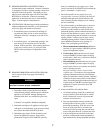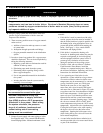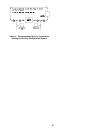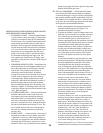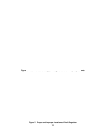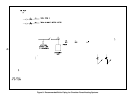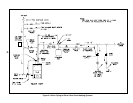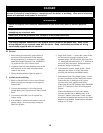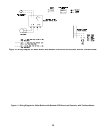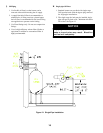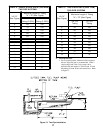10
THE FOLLOWING GUIDELINES SHOULD BE FOLLOWED
WHEN PIPING THE TANKLESS HEATER:
1. FLOW REGULATION — If flow through the heater
is greater than its rating, the supply of adequate hot
water may not be able to keep up with the demand.
For this reason a flow regulator matching the heater
rating should be installed in the cold water line to
the heater. The flow regulator should preferably be
located below the inlet to the heater and a minimum
of 3’ away from the inlet so that the regulator is not
subjected to excess temperatures that may occur
during “off” periods when it is possible for heat to
be conducted back through the supply line. The
flow regulator also limits the flow of supply water
regardless of inlet pressure variations in the range of
20 to 125 psi.
2. TEMPERING OF HOT WATER — Installation of an
automatic mixing valve will lengthen the delivery of
the available hot water by mixing some cold water
with the hot. This prevents the possibility of
scalding hot water at the fixtures. In addition,
savings of hot water will be achieved since the user
will not waste as much hot water while seeking a
water temperature. Higher temperature hot water
required by dishwashers and automatic washers is
possible by piping the hot water from the heater
prior to entering the mixing valve. The mixing valve
should be “trapped” by installing it below the cold
water inlet to heater to prevent lime formation in the
valve. Refer to Figure 5.
3. FLUSHING OF HEATER — All water contains some
sediment which settles on the inside of the coil.
Consequently, the heater should be periodically
backwashed. This is accomplished by installing
hose bibs as illustrated and allowing water at city
pressure to run into hose bib A, through the heater,
and out hose bib B until the discharge is clear. The
tees in which the hose bibs are located should be
the same size as heater connections to minimize
pressure drop.
4. HARD WATER — A water analysis is necessary to
determine the hardness of your potable water. This
is applicable to some city water and particularly to
well water. An appropriate water softener should be
installed based on the analysis and dealer’s recom-
mendation. This is not only beneficial to the tankless
heater but to piping and fixtures plus the many other
benefits derived from soft water.
G. INSTALL SMOKEPIPE — The HF should be vented
into a fireclay tile-lined masonry chimney or chimney
constructed from type L vent or a factory built chimney
that complies with the type HT requirements of UL103.
The chimney and vent pipe shall have a sufficient draft
at all times, to assure safe proper operation of the boiler.
See Figure 6 for recommended installation.
1. Install a draft regulator following the instructions
furnished with the regulator. See Figure 7 for
alternate draft regulator locations.
2. Consider the chimney overall. Chimneys that have a
high heat loss may become less suitable as the heat
loss of the home goes down and the efficiency of
the boiler installed goes up. Most homes have a
chimney appropriate for the fuel and the era in which
the home was built. That may have been a coal fired
or an inefficient oil fired boiler built into a home
without insulation or storm windows. With increas-
ing fuel prices that home probably has been insu-
lated and fitted with storm windows so that the heat
loss of the home has been reduced. This requires
less fuel to be burned and sends less heat up the
chimney.
A new boiler probably has a higher efficiency than
the boiler being replaced. That probably means that
the stack temperature from the new boiler will be
lower than that from the old boiler and with less
room air being drawn up the chimney to dilute the
stack gases. The combination of a large uninsulated
chimney, reduced firing rate, reduced firing time,
lower stack temperature and less dilution air can, in
some cases, contribute to the condensing of small
amounts of water vapor in the chimney. Such
condensation, when it occurs, can cause chimney
deterioration. In extreme cases, condensed water
may be visible on the outside of the breeching or
chimney. In those extreme cases, the chimney may
have to be lined to insulate the chimney and thus
prevent the condensation. The addition of dilution
air into the chimney may assist in drying the
chimney interior surfaces.
A massive chimney on a cold, or exposed outside
wall may have produced adequate draft when it was
fired with a higher input and greater volumes of
heated gases. With reduced input and volume, the
draft may be severely affected. In one instance our
research showed a new chimney of adequate sizing
produced only -.035" W.C. after 30 minutes of
continuous firing at 13.0% CO
2
. Outside wall
chimneys take longer to heat up and can have .00"
W.C. draft at burner startup. You may have to
consider a special alloy chimney flue liner with
insulation around it and a stabilizing draft cap or
even a draft inducing fan in severe cases.
3. For the same reasons as in (2.) above, heat extractors
mounted into the breeching are not recommended.



